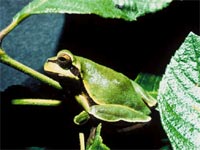why are the forgs is green?
On frog skin there are 3 levels of pigment cells. They work together to bring out the distinctive green color. These pigment cells called chromatophores lie on top of each other. The bottom layer is melanophores. They contain melanin, a pigment that is dark brown, black and also gives skin color.
On these cells are iridophores. Although this layer of cells does not necessarily produce skin color, they reflect light on the surface of transparent cells in the cell. When light hits these cells, they create iridescence in frogs, as well as in amphibians, fish and invertebrates.
 (Photo: LiveScience) In most green frogs, sunlight passes through the skin to small mirrors on the iridophores. The reflected light is blue.
(Photo: LiveScience) In most green frogs, sunlight passes through the skin to small mirrors on the iridophores. The reflected light is blue.
This blue light passes through the top cell layer called xanthophores, which contains yellow pigment. Light when filtered through this top layer of cells becomes green in the human eye. Frogs without xanthophores will be light blue.
Many frogs rely on their skin color to defend themselves against predators. These layers of pigment cells can change the skin color of frogs from fresh green to dark brown. This ability helps frogs to hide in their surroundings.
Frog hormones can change cell shape, move pigmentation in cells and change the density of light passing through them. When the frog jumps from a green leaf to a prison pond, the cells in the skin adjust the frog's color to match the situation and help it hide.
MT
- Why do we get green tea?
- Green bananas and 13 good health effects you don't know
- 5 reasons you should drink green tea with honey every day
- Why are leaves green?
- Food taste from green cabbage
- Photo: Divers create designs with giant green turtles
- Go Green Club helps farmers manage waste
- Drinking green tea to stay happy
- The world's most 'green' cities
- Cooperation on green growth for sustainable development
- 3 ways to grow super simple green onions at home
- Video: Mysterious green sphere glows in the sky of South America
 Animal 'suffering' after hibernation
Animal 'suffering' after hibernation Why do goats climb well?
Why do goats climb well? Scientists were surprised to see chimpanzees eating turtles
Scientists were surprised to see chimpanzees eating turtles Giant catfish died deadly due to drought in Thailand
Giant catfish died deadly due to drought in Thailand